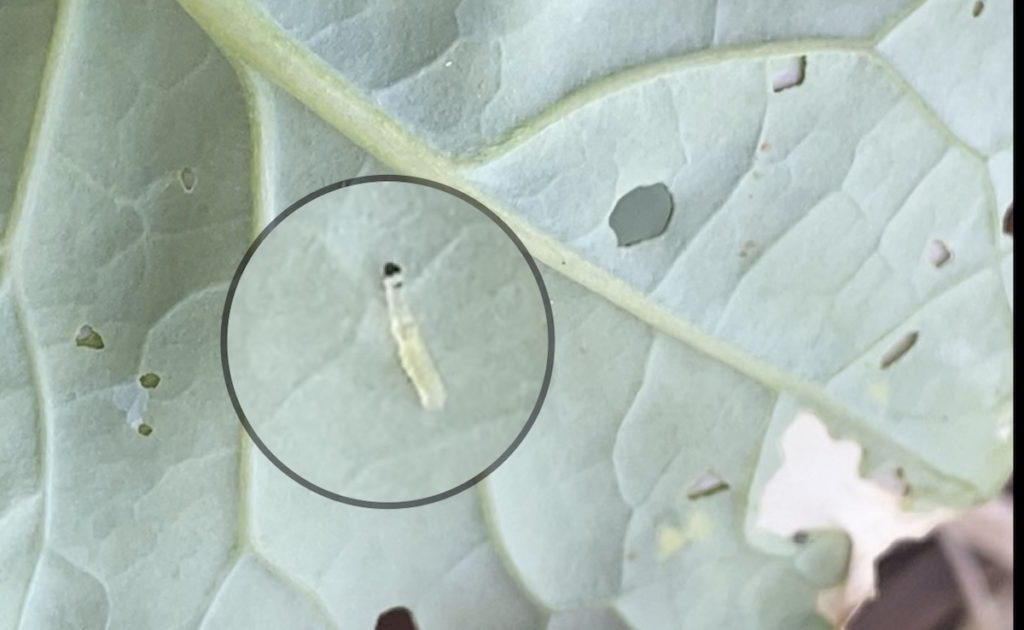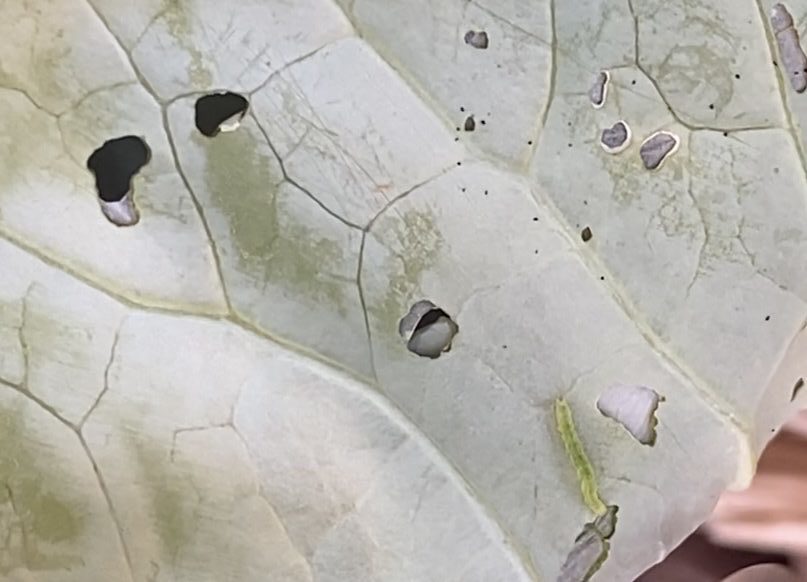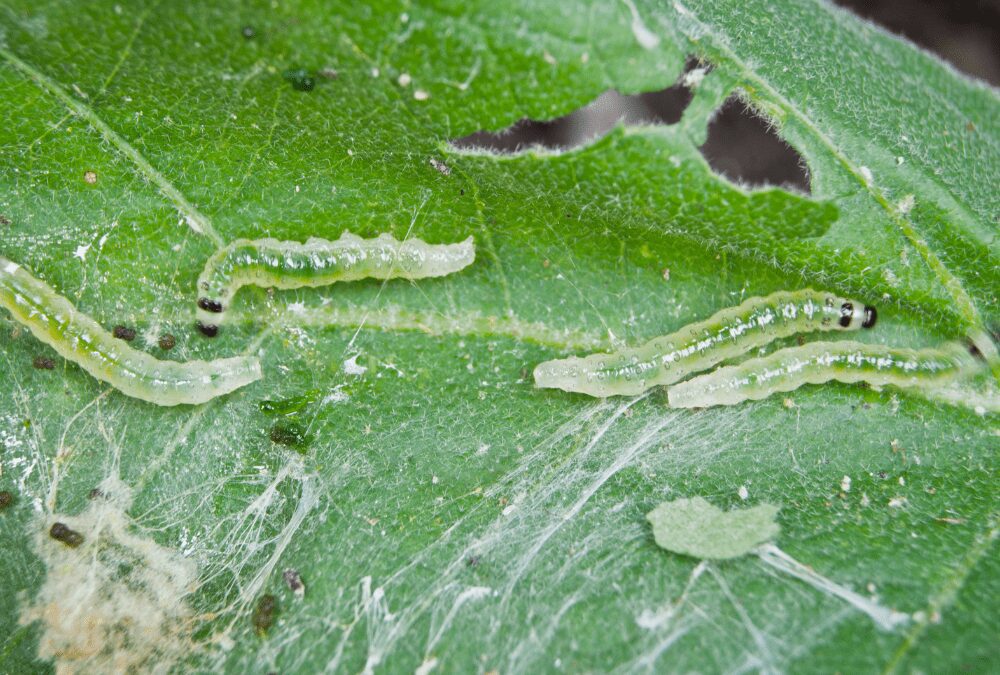Cole crops are lining the tables at Rainbow Gardens with the promise of antioxidant-rich veggies at harvest time. That sounds great, right? There is, however, a certain pest that can crush the promise of fresh veggies into smithereens if you are not watching for it diligently. The cabbage looper is a master at disguise and a quick ravager. Sometimes you don’t even know you have a cabbage looper until the damage appears. Just know that with cole crops, comes the cabbage looper. This pest is hard to prevent but it can be controlled. Let’s take a look.

Identifying Cabbage Loopers
Cabbage Loopers are the larvae of an inconspicuous brown moth. The moth lays its eggs on the undersides of leaves on cole crops like broccoli, cauliflower, Brusselsprouts, kale and many other types of veggies too. The eggs are tiny, smooth, light-green in color and somewhat flat. in about 3 days they hatch and tiny green caterpillars immediately begin munching the undersides of your veggies and they won’t stop for the next 4 weeks. That’s a lot of eating!
When just hatched, cabbage loopers are incredibly small and can be cunningly camouflaged (especially the green ones). If they are lying next to a a fat vein on a broccoli leaf, it can be really hard to see them. As the loopers grow, you’ll still find them hanging out on the back of leaves, but they also like to congregate in the center crevices of the plant. Cabbage loopers can range in color from light green to dark brown with dark and/or light-colored stripes down the body, but most grow to be about 2 inches long before they spin a cocoon where they will develop into a moth over 14 days (unless they overwinter).
As they grow, cabbage loopers become more noticeable, but there is generally a sufficient amount of damage already done. Let’s take a look at the damage.


Identifying Damage by Cabbage Loopers
When checking for cabbage loopers it is imperative that you turn over each and every leaf and look closely. They love to hide out on the bottom of leaves, especially just after hatching.
The first sign of damage from cabbage loopers that is likely to show on your cole crops are holes. You’ll see irregular spots on the leaves and when you look closer, you’ll see that sometimes the chewing hasn’t quite gone all the way through. It may look like a little layer of cellophane is in the hole. The cabbage looper has eaten all the ‘green’ out of that section of the leaf. Holes are generally found inbetween major leaf veins
As the cabbage loopers and their appetites get bigger, so do the holes and the damage. You’ll see that now the holes are indeed holes and go straight through, and parts of the leaf are now tattered and torn. It becomes definitely apparent that something is taking a bite out of your veggies. Severe infestation of cabbage loopers, leaves your cole crops looking positively skeletonized and/or defoliated.


Control for Cabbage Loopers
As I mentioned before, it is difficult to prevent cabbage loopers from venturing onto your cole crops from the get go. Unless you are growing your veggies in a greenhouse, or you are thoroughly checking for eggs or larvae before you plant and covering your crops with netting that is 100% secure, you probably will come across cabbage loopers. Your best bet is early detection (that means checking everyday) and the following pest control products.
Bt (Bacillus thuringiensis) is an organic product that specifically targets caterpillars and worms. It is not, however, a selective spray. This means that it will kill ALL caterpillars or worms that come in contact with it, butterfly caterpillars included. It is important to look for caterpillars you wish to protect and relocate them before you spray Bt for cabbage loopers. You spray your vegetables and the cabbage loopers ingest the product as they eat the foliage that has been treated.
Spinosad is another product that controls cabbage loopers. This product kills caterpillars and worms along with spider mites, borers, beetles and a slew of other pests. It is also an organic control (which is best when treating vegetables).
Whichever control you decide to use, a follow up application will be needed. Follow the product label to know when you need to apply again. Put a reminder in your phone so you don’t forget! You’ll most likely need more than 2 applications.
A good tip we received at our recent class hosted by Board Certified Entomologist, Molly Keck, is to alternate products each time you spray. Insects can build up an immunity to pest controls, especially if they are being subjected to the same one every time. Alternating Bt one week and then spraying with Spinosad 14 days later (or whatever the label advises) gives you a better shot at clearing up your cabbage loopers for good.
Important Info: You must also be mindful NOT to spray during the heat of the day when temperatures are high (really anything over 80°F) or you risk burning your plants. A tip from one of our Vegetable Specialist, Karen Gardner, Bexar County Master Gardener, is to spray at night and then wash off the residue in the morning with water from the hose. This way you are not spraying during the day when it is hot enough to burn your plants, OR when bees are actively pollinating as they can be killed as well. This way the product has all night to target the cabbage loopers and by washing off the residue in the morning, there is less chance to bring harm to beneficial insects in your garden. It’s a win-win!


There you have it. The ins and outs of cabbage loopers. Don’t let this deter you from growing delicious cole crops in your fall/winter gardens. Just be diligent and observant because early detection is key to successful control of cabbage loppers. I hope you feel armed with the knowledge you need to battle these inevitable but controllable pests.
~The Happy Gardener, Lisa Mulroy

